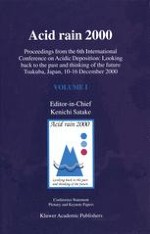2001 | OriginalPaper | Buchkapitel
Reacidification Effects on Water Chemistry and Plankton in a Limed Lake in Sweden
verfasst von : Frida Edberg, Paul Andersson, Hans Borg, Christina Ekström, Einar Hörnström
Erschienen in: Acid rain 2000
Verlag: Springer Netherlands
Enthalten in: Professional Book Archive
Aktivieren Sie unsere intelligente Suche, um passende Fachinhalte oder Patente zu finden.
Wählen Sie Textabschnitte aus um mit Künstlicher Intelligenz passenden Patente zu finden. powered by
Markieren Sie Textabschnitte, um KI-gestützt weitere passende Inhalte zu finden. powered by
Water chemistry and plankton has been monitored in three Lakes in Tyresta National park SE of Stockholm since 1977. Liming operations started in Lake Langsjön and Lake Trehörningen in 1978 and were repeated every 3–5 years, while Lake Årsjön is an unlimed reference Lake. During 1991–1999, the annual pH median in Lake Langsjön and Lake Årsjön ranged between 6.6–7.1 and 5.2–5.8, respectively, and the composition of phyto- and Zooplankton in these lakes did not change markedly. After a final treatment in 1991, the liming of Lake Trehörningen was terminated intentionally. As a result, pH decreased from an annual median 7.1 in 1991, to 6.1 in 1999 (5.8 in 1998). Total organic carbon (TOC) did not change markedly during this period, while the levels of calcium decreased. Metals, known to be influenced by acidification, especially cadmium, manganese and aluminium (Al), increased. The labileinorganic forms of Al also reached higher levels, especially in 1998. Following the decreasing pH, the total number of phytoplankton taxa decreased by ca 40%. Among Zooplankton, the cladocerans Holopedium gibberum, Diaphanosoma brachyurum and Daphnia longispina, common during the limed period, became rare.
